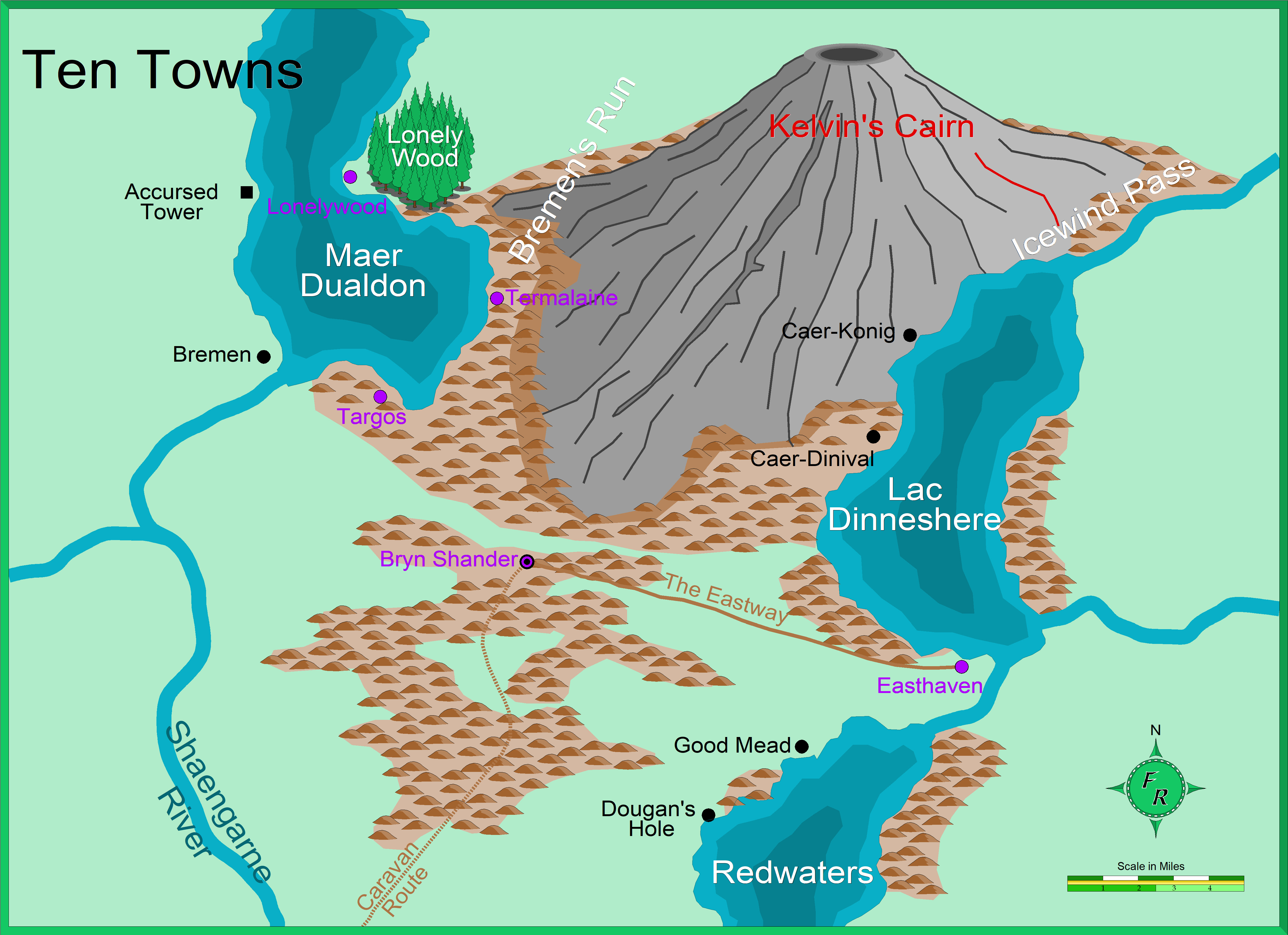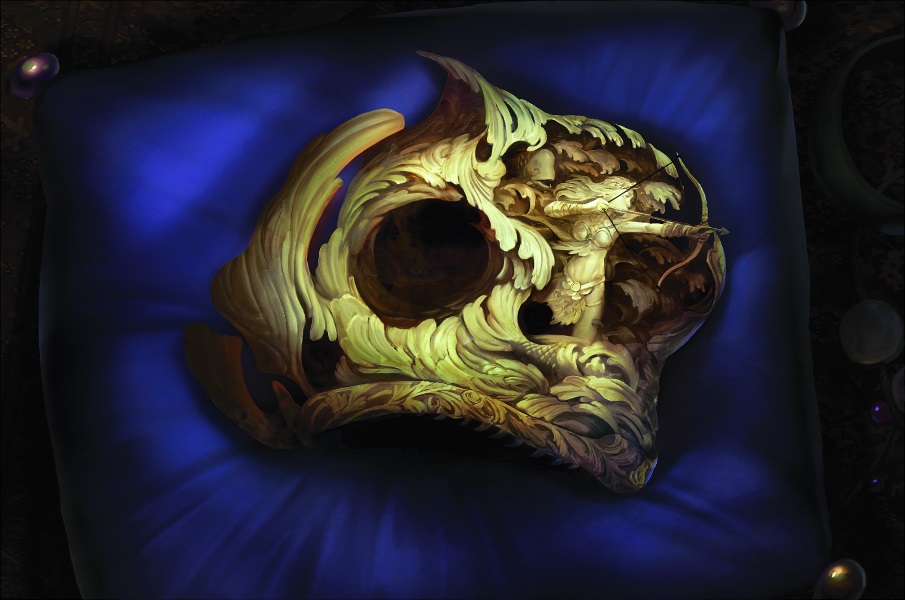Десять городов - Ten Towns
Why people live in Ten-Towns
White Gold - There is a fish, the knucklehead trout, that has bones made out of Ivory. The three lakes around Ten-Towns are the only location they exist and they sell for big cash. Solitude - Outcasts, fugitives, or pariahs in search of a place where they can be tolerated, if not accepted. ExBarbarians - After the war of the Crystal Shard (100 years ago), barbarians left the Reghead Tribes and settled in Ten-Towns Native - Ten-Towns is 600 years old, people were born there and it's all they know.Life in Ten-Towns
Life is hard work and demands cooperation. No one can make it on their own, even fugitives and scoundrels. People in Ten-Towns are a diverse group from all over Fayrun. Each town are not friends- they are fierce competitors. But everyone in each town are close comrades. Think of European soccer teams. Luber is scarce. Stone buildings. Pitched roofs. Comfort/warmth over style. Each town has a speaker who leads the community and represents its interests 8 times a year. See blow for their names. Fishing the LakesEdit Without knucklehead trout, there would be no Ten-Towns. Every part of the trout is useful. Even the smaller bones can be fashioned into valuable trinkets like arrow heads. Except Bryn Shander every town is built on the shore of one of the three lakes The fishing boats are simple. Smallest: one-masted skiff (rowed Largest: two-masted cogs with single decks. Each ship waves the flag of their town, not the fishermen. When they find a family of fish they wave the flag and fire a cannon. The towns compete fiercely to fire more cannons. Fishing is really dangerous, and demand cooperation. There are small boats that don't share with the town and ride independent but they are small and don't last long. Lakes are frozen during the winter.Scrimshaw
Taking the smaller ivory bones of the knuchlehead trout and carving them into ornate shapes. Acomplished scrimshanders are very respected in Ten-Towns Drawing pictures on the flat surface and inking them Carving out small statuesLife in Ten-Towns
In the markets of Bryn Shander, improbably enough, folk from every far-flung region buy and sell. Spice traders from Calimshan, farriers from the wild lands of the Silver Marches, cloth merchants from Cormyr, and merchants with armor and lumber from the Moonshae Isles are just a few of the traders who join the rough-and-tumble caravans from Luskan to bring their wares to Ten-Towns. Icewind Dale has precious few trees, so lumber for building is imported from southern lands or cut from the slopes of the Spine of the World. Stones from Kelvin’s Cairn or the dwarven valley supplement wood i building material. Homes have sharply pitched roofs to prevent snow from accumulating on them. Comfort—specifically, warmth—always trumps fashion in the frigid north. The people of Ten-Towns wear layers of woolen clothing, often topped off with fur cloaks. The careful layering of different-colored cloth creates a simple form of ornamentation. Bright reds and blues help to enliven the dark winter months. The traditional crafts of Ten-Towns involve intricate designs incorporating wirework and the knucklehead scrim shaw for which the region is famous. Each of the towns has an elected speaker who leads the community and represents its interests. Roughly eight times a year, weather permitting, all the speakers gather in the council hall in Bryn Shander to discuss matters of shared interest. These meetings usually devolve into petty arguments about fishing territories, but occasionally they deal with more serious matters. The speaker of Bryn Shander, currently Duvessa Shane, is the nominal head of this council. Even fugitives and scoundrels who settle in Ten-Towns eventually learn that they need to contribute to the com mu nity if they want to survive. Every so often, though, miscreants arrive in Icewind Dale, often from the crime-ridden city of Luskan, and try to live off the work of others. They rarely last long.Life Off the Lake
Except for Bryn Shander, each of the ten towns is built on the shore of one of the three lakes where knuckle¬head trout swim, surrounding the mountain of Kelvin’s Cairn. The largest population is in Maer Dualdon, the deepest of the lakes. Ten-Towns fishing boats are generally simple affairs. The smallest are one-masted skiffs, which are rowed as often as oared—not least because the harsh winds of the dale can capsize such small craft. Larger, two-masted cogs with single decks handle the wind better, and their crews exemplify the neighborly cooperation that makes Ten-Towns function. These ships fly the flags of their towns and provide fish for the whole community, not for any individual fisher. A ship that makes a catch raises a red flag on its mast. The higher the flag, the larger the trout, with a flag at the top of the mast signifying a catch of at least a four-footer. The flag signals the other ships of that town’s fleet that a school is in the area, but it can also attract the attention of ships from other towns. The large and wily knucklehead trout can’t easily be caught in nets, and reeling such a strong fish in on a line is a significant undertaking—one more reason why cooperation is essential to survival in Icewind Dale. The sight of a knucklehead jumping and thrashing on the end of a fisher’s line can be entertaining, but it also represents real danger. Incautious fishers who fall overboard can die before the rest of the crew can get them out of the frigid water. All three lakes freeze in winter, though Redwaters is the only one that freezes completely over in most years. When thick ice covers the lakes, many fishers stay to the shelters of their homes and hearths, but the most dedicated or desperate cut holes in the ice and dangle their lines down in hopes of tempting hungry trout. FISHING THE LAKES Without knucklehead trout, there would be no Ten-Towns. A dramatic statement, perhaps, but it is hard to imagine any pioneers deciding to make a permanent home in Icewind Dale without the bony-headed fish. The trout are a major food source for the people of Ten-Towns, and their hard, smooth bones are tremendously useful. The large, fist-shaped protrusions atop their skulls are well suited to carving, and talented scrimshanders earn a respectable living selling their wares in Bryn Shander and in the south-which is why knucklehead bone is commonly called “white gold” in Icewind Dale. Although the fish’s head is the part best suited for artistic carving, many of its smaller bones can be carved into sewing needles, arrowheads, fish hooks, fasteners, and similar items. Thus, a single trout (which can reach up to five feet long) is quite valuable, even leaving aside the meat it provides. Each of the ten towns (except landlocked Bryn Shander) maintains a fleet of fishing vessels. For the most part, fishing is a com¬munal activity. All the larger boats and most of the smaller ones are owned by the towns, not individu¬als, and the catch likewise belongs to the town, to be shared according to need. Targos and Easthaven, the largest towns after Bryn Shander, have fleets of over a hundred boats. Some people—mostly newcomers to the area who hope to make their fortunes off the trout-have their own smaller boats and try to fish the lakes independently. The towns frown on this activity, since it threatens both the trout population and the delicate relation¬ships among the communities, which have carefully divided up fishing rights on the lakes. It’s also dan-gerous-smaller boats don’t handle the winds as well, and it can be difficult to land a large trout on a small craft. Most small boats stay close to shore, using lines or nets to catch smaller fish.SCRIMSHAW
Scrimshaw as it is practiced in Icewind Dale includes a variety of techniques and styles. The simplest (which is still extremely intricate) involves engraving pic¬tures into the smooth surface of the bone and inking the engraved lines. More smaller boats and try to fish the lakes independently. The towns frown on this activity, since it threatens both the trout population and the delicate relation¬ships among the communities, which have carefully divided up fishing rights on the lakes. It’s also dan-gerous-smaller boats don’t handle the winds as well, and it can be difficult to land a large trout on a small craft. Most small boats stay close to shore, using lines or nets to catch smaller fish.Если вы хотите что то добавить или присоединится к команде редакторов - пишите комментарии
Внимание! Имеется скрытый контент, доступный только подписчикам. Подписка - бесплатна. Детальнее - читай здесь.
Вы можете присвоить себе следующие роли, чтобы расширить видимый контент: Silver Marches Daggerford Baldur's Gate Neverwinter Waterdeep Deadsnows
RSS канал данного сайта Подпишитесь на Boosty или Patreon








Комментарии